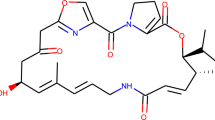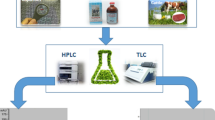Abstract
Efficient analytical methods are required for optimizing dosage of veterinary antibiotics and hormones in order to reduce toxicity and antimicrobial resistance in the environment. Thus, the objective of this work was to develop a rapid and low-cost method for determination of hormone estradiol and antibiotic chlortetracycline in bovine and porcine blood serum by aqueous two-phase system (ATPS) extraction and capillary electrophoresis quantification. ATPS based on ionic liquid cholinium alaninate and citrate salt along with mixtures of protic and aprotic polar solvents were evaluated in terms of recovery of extraction (%R). The liquid-liquid equilibrium, phase diagrams, and tie lines are discussed. Antibiotic migrated to solvent-rich phase (R ≈ 89.0%) to all systems. Estradiol migrates to ionic liquid-rich phase; however, addition of 10% methanol changed partition to solvent-rich phase (R ≈ 89.7%). The method has high recovery and cleanliness, is cost-efficient, scalable, and hence is adequate for screening of antibiotics and hormones tested in animal blood serum for dosage optimization and to predict their environment.




Similar content being viewed by others
References
Álvarez MS, Gómez L, Ulloa RG, Deive FJ, Sanromán MA, Rodríguez A (2016) Antibiotics in swine husbandry effluents: laying the foundations for their efficient removal with a biocompatible ionic liquid. Chem Eng J 298:10–16
Atkinson SK, Marlatt VL, Kimpe LE, Lean DR, Trudeau VL, Blais JM (2012) The occurrence of steroidal estrogens in South-Eastern Ontario wastewater treatment plants. Sci Total Environ 430:119–125
Borecka M, Białk-Bielińska A, Siedlewicz G, Kornowska K, Kumirska J, Stepnowski P, Pazdro K (2013) A new approach for the estimation of expanded uncertainty of results of an analytical method developed for determining antibiotics in seawater using solid-phase extraction disks and liquid chromatography coupled with tandem mass spectrometry technique. J Chromatogr A 1304:138–146
Brooks BW, Brain RA, Huggett DB, Ankley GT (2010) Veterinary pharmaceuticals in the environment, vol 1018. American Chemical Society, Washington, pp 205–223
Diaz-Quiroz CA, Francisco Hernandez-Chavez J, Ulloa-Mercado G, Gortares-Moroyoqui P, Martinez-Macias R, Meza-Escalante E, Serrano-Palacios D (2018) Simultaneous quantification of antibiotics in wastewater from pig farms by capillary electrophoresis. J Chromatogr B Anal Technol Biomed Life Sci 1092:386–393
Dinis TBV, Passos H, Lima DLD, Esteves VI, Coutinho JAP, Freire MG (2015) One-step extraction and concentration of estrogens for an adequate monitoring of wastewater using ionic-liquid-based aqueous biphasic systems. Green Chem 17:2570–2579
Farias FO, Passos H, Sanglard MG, Igarashi-Mafra L, Coutinho JAP, Mafra MR (2018) Designer solvent ability of alcohols in aqueous biphasic systems composed of deep eutectic solvents and potassium phosphate. Sep Purif Technol 200:84–93
Freire MG, Claudio AF, Araujo JM, Coutinho JA, Marrucho IM, Canongia Lopes JN, Rebelo LP (2012) Aqueous biphasic systems: a boost brought about by using ionic liquids. Chem Soc Rev 41:4966–4995
Gathergood N, Garcia MT, Scammells PJ (2004) Biodegradable ionic liquids. Part I. Concept, preliminary targets and evaluation. Green Chem 6:166
Hernando MD, Mezcua M, Fernández-Alba AR, Barceló D (2006) Environmental risk assessment of pharmaceutical residues in wastewater effluents, surface waters and sediments. Talanta 69:334–342
Kümmerer K (2009) The presence of pharmaceuticals in the environment due to human use—present knowledge and future challenges. J Environ Manag 90:2354–2366
Morandeira L, Álvarez MS, Deive FJ, Sanromán MÁ, Rodríguez A (2017a) Contriving to selectively separate drugs with a hydrophilic ionic liquid. Sep Purif Technol 174:29–38
Morandeira L, Álvarez MS, Markiewicz M, Stolte S, Rodríguez A, Sanromán MÁ, Deive FJ (2017b) Testing true choline ionic liquid biocompatibility from a biotechnological standpoint. ACS Sustain Chem Eng 5:8302–8309
Nieto A, Borrull F, Pocurull E, Marcé RM (2008) Determination of natural and synthetic estrogens and their conjugates in sewage sludge by pressurized liquid extraction and liquid chromatography-tandem mass spectrometry. J Chromatogr A 1213:224–230
Othmer D, Tobias P (1942) Liquid-liquid extraction data—the line correlation. Ind Eng Chem 34:693–696
Petkovic M, Ferguson JL, Gunaratne HQN, Ferreira R, Leitão MC, Seddon KR, Rebelo LPN, Pereira CS (2010) Novel biocompatible cholinium-based ionic liquids—toxicity and biodegradability. Green Chem 12:643
Quirino JP, Kim J-B, Terabe S (2002) Sweeping: concentration mechanism and applications to high-sensitivity analysis in capillary electrophoresis. J Chromatogr A 965:357–373
Rizzo L, Manaia C, Merlin C, Schwartz T, Dagot C, Ploy MC, Michael I, Fatta-Kassinos D (2013) Urban wastewater treatment plants as hotspots for antibiotic resistant bacteria and genes spread into the environment: a review. Sci Total Environ 447:345–360
Santos LHMLM, Araújo AN, Fachini A, Pena A, Delerue-Matos C, Montenegro MCBSM (2010) Ecotoxicological aspects related to the presence of pharmaceuticals in the aquatic environment. J Hazard Mater 175:45–95
Sarmah AK, Meyer MT, Boxall ABA (2006) A global perspective on the use, sales, exposure pathways, occurrence, fate and effects of veterinary antibiotics (VAs) in the environment. Chemosphere 65:725–759
Song CP, Ramanan RN, Vijayaraghavan R, Macfarlane DR, Chan ES, Ooi CW (2015) Green, aqueous two-phase systems based on cholinium aminoate ionic liquids with tunable hydrophobicity and charge density. ACS Sustain Chem Eng 3:3291–3298
Wang Y, Hu S, Han J, Yan Y (2010): Measurement and correlation of phase diagram data for several hydrophilic alcohol + citrate aqueous two-phase systems at 298. 15 K. 4574–4579
Funding
We appreciate the financing support of Instituto Tecnológico de Sonora through the PROFAPI program (PROFAPI 2019_0026); C. Díaz would like to acknowledge the scholarship from CONACYT.
Author information
Authors and Affiliations
Corresponding authors
Additional information
Responsible editor: Ester Heath
Publisher’s note
Springer Nature remains neutral with regard to jurisdictional claims in published maps and institutional affiliations.
Electronic supplementary material
ESM 1
(DOCX 16 kb)
Rights and permissions
About this article
Cite this article
Díaz-Quiroz, C., Hernández-Chávez, J.F., Ulloa-Mercado, G. et al. Simultaneous extraction of antibiotic and estrogen from animal blood serum using aqueous two-phase systems as predictor of environmental impact. Environ Sci Pollut Res 27, 28536–28544 (2020). https://doi.org/10.1007/s11356-020-07770-z
Received:
Accepted:
Published:
Issue Date:
DOI: https://doi.org/10.1007/s11356-020-07770-z




